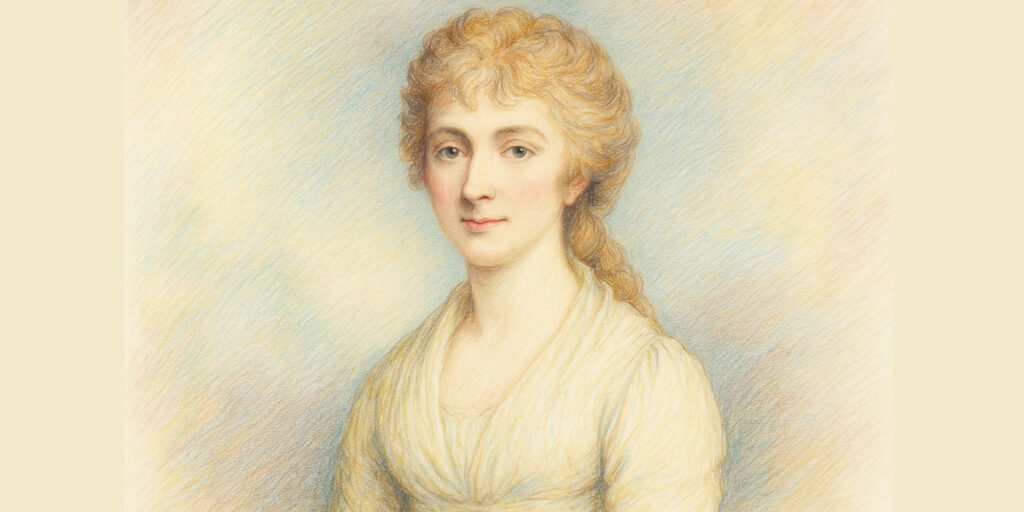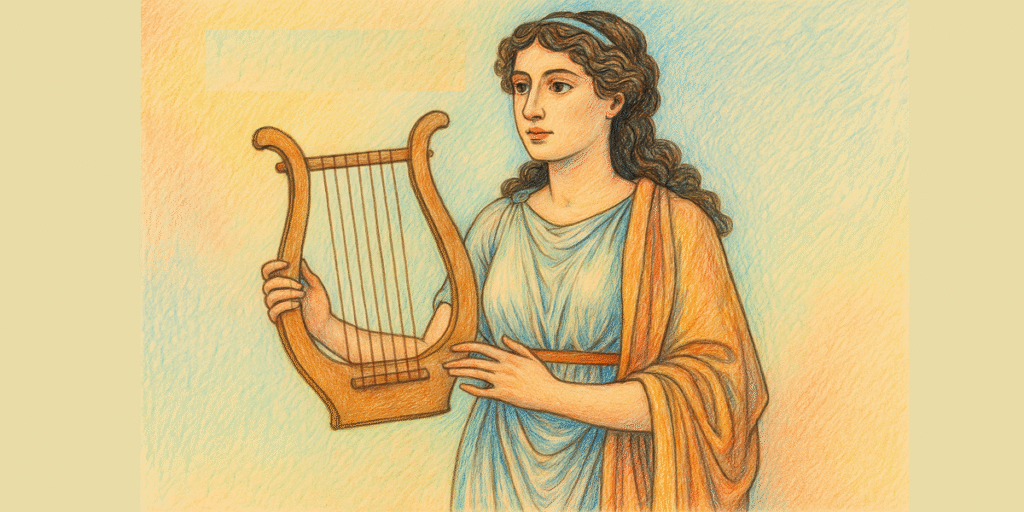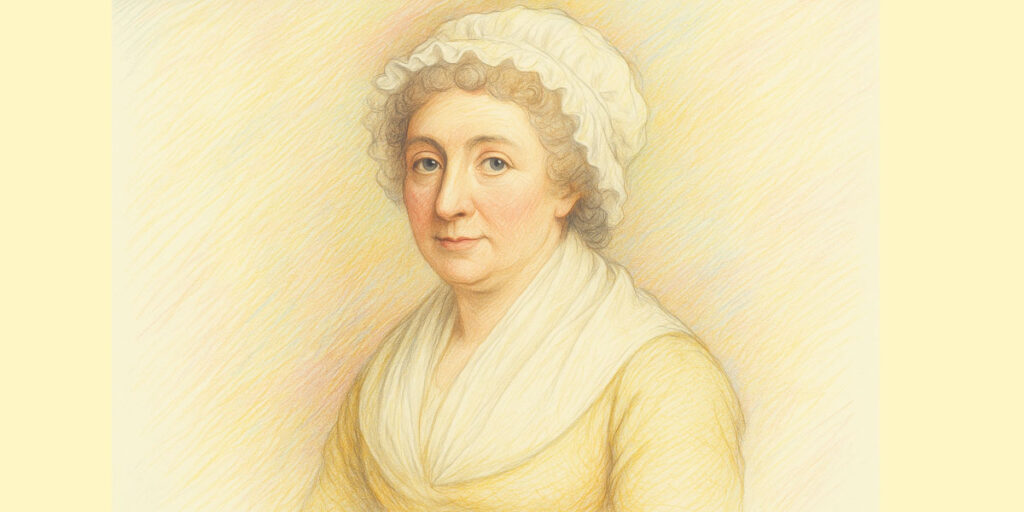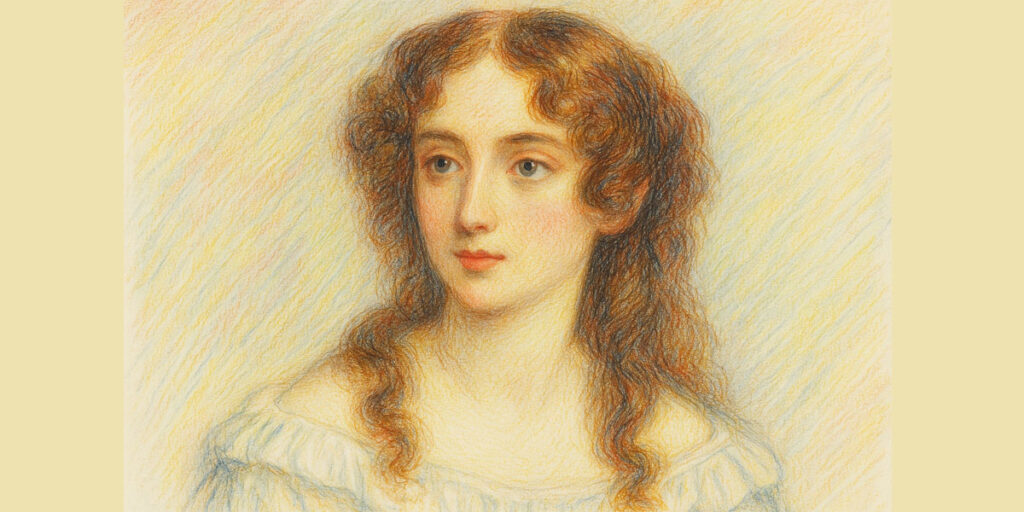Charlotte Turner Smith stands among the pivotal figures bridging 18th-century sensibility and the dawn of Romanticism in England. Poet, novelist, and critic, she transformed personal adversity into art, pioneering new poetic forms and championing social causes—particularly the abolition of slavery and the condition of women and the poor. While often overshadowed by later Romantics such as Wordsworth and Coleridge, Smith’s works exerted a profound influence on her contemporaries and subsequent generations, earning her the title “the mother of English Romanticism.” This biography traces her life from her genteel origins through her turbulent marriage, literary ascendancy, and enduring legacy.
Early Life and Family Background
Born Charlotte Turner on May 4, 1749, at Bignor Park House near Petworth in Sussex, she was the daughter of Nicholas Turner, a landed gentleman of modest means, and Anne Dashwood. The Java-blue walls and curtained windows of Bignor Park held little real wealth: the Turner family lived precariously on dwindling inheritance. Charlotte grew up alongside three younger sisters, navigating the strictures of 18th-century gentry life—accomplishments in music, French, and needlework, tempered by reading Shakespeare, Milton, and classical myths.
Charlotte’s childhood, though sheltered, was marked by financial anxiety. The sudden death of her mother when Charlotte was eight and Nicholas Turner’s imprudent speculations left the family burdened by debt. Nevertheless, Charlotte exhibited early literary promise: at ten, she transcribed poems and penned imaginary dialogues between Virgil’s Dido and Aeneas. Her father’s acquaintances—local clergymen, lawyers, and minor gentry—introduced her to philosophical and political discussions, fostering her acute moral sensibility.
Education and Formative Influences
In lieu of formal schooling, Charlotte’s education was shaped by tutors at home and voracious self-instruction. French literature—Hugo, Racine, and Voltaire—kindled her taste for classical elegance and sharp social commentary. Latin and Greek were discouraged for young ladies, but she gleaned what she could from her father’s library. Shakespeare’s tragedies awakened in her an appreciation for emotional depth; Pope’s heroic couplets honed her ear for rhythm and rhyme.
A transformative influence was the itinerant actress-playwright Charlotte Dawnay, whom Charlotte Turner met at age sixteen. Dawnay’s independence, public success, and anecdotal stories of life on the stage contrasted sharply with the Turner family’s constrained circumstances. Under Dawnay’s mentorship, Charlotte gained confidence to write beyond polite “accomplishments,” daring to express passion and political conviction. By her late teens, she was drafting elegies on the death of friends, meditating on mortality and the social inequities she observed in nearby Petworth Park’s tenants.
Marriage and Personal Struggles
In June 1769, at age twenty, Charlotte Turner married Benjamin Smith, a prosperous but unscrupulous attorney from Hastings. Despite his respectable appearance, Benjamin’s debts soon eclipsed any expectations of financial stability. The couple had twelve children over the next sixteen years; most survived infancy, but the fragile health of their offspring deepened Charlotte’s anxieties.
Benjamin’s legal career faltered under the weight of gambling debts and poor investments. Court actions loomed; creditors pounded at their door. Charlotte, once a sheltered gentlewoman, found herself negotiating with moneylenders and pawning family silver. Her husband’s profligacy, combined with her daughter’s chronic illness and her own recurring bouts of ill health, plunged the family into near-penury. Seeking to alleviate their burdens, Charlotte turned to writing professionally—an uncommon recourse for women of her class.
Entry into Literary Life
Charlotte Smith’s literary debut came in 1780 with Elegiac Sonnets, a collection published anonymously in two volumes. Though conventional poetic volumes sold poorly, her sonnets captured the public’s imagination with sincere emotion, musical cadence, and innovative subject matter—lamenting the loss of summer landscapes, the absence of a beloved friend, the plight of the poor. Within months, critics and readers speculated on the author’s identity; her frank expressions of sorrow and disillusionment struck a chord in an age increasingly sensitive to personal sentiment.
Emboldened by the success of her sonnets, Smith expanded into prose. Her first novel, Emmeline: or The Orphan of the Castle (1788), combined Gothic elements with social critique. Here, Smith narrated the emotional and financial vulnerabilities of women, underscoring inheritance laws and marital coercion. Though reviews were mixed—some praising her moral earnestness, others mocking her “sentimental” style—Emmeline sold steadily, encouraging her to pursue fiction alongside poetry.
Poetry: Elegiac Sonnets and Poetic Innovations
Smith’s Elegiac Sonnets (1780–1784) represent her most enduring poetic achievement. She wrote 86 sonnets across five editions, refining the sonnet form by loosening the rigid Petrarchan structure in favor of English patterns and an emotional directness that prefigured Wordsworth’s notion of “language really used by men.” Typical themes include:
- Natural Landscapes: Smith lamented the transformation of rural England by enclosure, mourning lost meadows and hedgerows, and aligning nature’s rights with human freedom.
- Personal Grief: Poems such as “Sonnet XLIV: On Being Cautioned…” reveal her distrust of corrupt legal systems, while “Sonnet XXII: Why Doth the Tempest” evokes familial anguish.
- Political Sympathy: Smith’s later sonnets, notably “Sonnet LXXV,” express ambivalence toward the French Revolution—initial hope for liberty, tempered by fear of violence and mob rule.
Her sonnets influenced Coleridge—who admired her “effusions of genuine sensibility”—and Wordsworth, who acknowledged debt to her careful attention to rustic detail. By infusing the sonnet with personal, political, and environmental concerns, Charlotte Smith transformed it from an ornamental form into a vehicle for serious reflection.
Novels: Pioneering Sensibility and Social Critique
Between 1788 and 1807, Smith published twelve novels and shorter tales, including Beachy Head (1807, posthumous) and Marchmont (1796). These works share hallmarks of the emerging Romantic novel: sympathetic heroines, Gothic settings, and moral earnestness. Yet they also interrogate systemic injustices:
- Inheritance Laws and Female Autonomy
In Celestina (1791), Smith portrays the legal subjugation of women: her protagonist is denied independent property, forced into an unhappy marriage. Smith underscores how coverture traps women, anticipating feminist arguments of the 19th century. - Rural Poaching and Poverty
In The Old Manor House (1793), rural characters resort to poaching to survive enclosure. Smith condemns the wealthy landowners’ cruelty while humanizing the poachers, challenging readers to reconsider moral judgments under systemic inequality. - French Revolution and Political Debate
Novels such as The Emigrants (1793) directly engage with contemporary politics. Sympathetic to émigrés fleeing the Terror, yet critical of aristocratic privilege, Smith explores revolutionary zeal and the limits of liberty.
Smith’s novels enjoyed commercial success but invited censure from conservative reviewers. Yet her readership—especially among women—grew, finding in her heroines’ moral fortitude and emotional honesty a reflection of their own aspirations.
Critical Prose and Translations
Beyond creative writing, Charlotte Smith contributed critical essays and translations. She translated Madame de Genlis’s Adèle de Senanges (1790) from French, elaborating on the didactic novel’s potential to reform society. Her prefaces often read like mini-treatises: in the 1796 edition of Rural Walks, a travelogue-poem hybrid, she argued for the moral and aesthetic value of rural scenery, opposing the destruction wrought by industrial progress.
Her prefaces, essays, and letters—published in magazines such as The Monthly Magazine—reveal a mind deeply concerned with aesthetics, education, and politics. She championed female education, advocated lenient treatment for debtors, and condemned the slave trade, aligning with the nascent abolitionist movement.
Political Engagement and Views
Charlotte Smith lived through seismic political upheavals: the American War of Independence, the French Revolution, and the Napoleonic Wars. Initially exhilarated by the promise of French liberty, she tempered enthusiasm with horror at the Terror. Her poetry and prose reflect this ambivalence: call for reform alongside caution against revolutionary violence.
She corresponded with prominent figures—William Godwin praised her moral insight; Mary Wollstonecraft found in Smith a kindred spirit. Although not an active pamphleteer, Smith’s novels circulated political ideas among a wide readership, subtly subverting the status quo at a time when direct political dissent by women was socially discouraged.
Later Years and Final Struggles
By the late 1790s, financial strains persisted. Benjamin Smith’s debts forced Charlotte to rent out her Sussex home, and she moved her large family between London, Bath, and Bristol, seeking cheaper lodging. Repeated grief stalked her: several children suffered chronic illness, one died at age five. Charlotte herself battled rheumatic pain, dysentery, and bouts of depression.
Despite adversity, she continued to write prodigiously. Her last book, Beachy Head, a long narrative poem, combines natural description, musical language, and social critique. Written in a rented cottage overlooking the cliffs, it warns against exploitation of both land and humanity. However, sales were modest; publisher incentives dwindled.
In 1806, weakened by years of toil and illness, Charlotte Smith died on October 28 at age 57 in Southampton. Her funeral, marked by a procession of local admirers and literary friends, closed an extraordinary life in which art and activism merged in poignant harmony.
Legacy and Influence
In her lifetime, Charlotte Smith sold thousands of copies of her poetry and novels—an accomplishment remarkable for a woman writer facing social constraints. Her immediate followers included the “Lyrical Ballads” circle: Wordsworth’s early sonnets echo Smith’s sensibility to nature’s moral voice; Coleridge’s interest in psychological depth owes a debt to her narratives.
Throughout the 19th century, critical fashions shifted: Scott’s historical romance and Austen’s domestic realism eclipsed Smith’s brand of political-sentimental prose. Yet feminist and Romantic scholars in the late 20th century reclaimed her significance. Contemporary critics highlight:
- Proto-Feminism: Smith’s exploration of women’s legal and economic vulnerability prefigures later feminist critiques.
- Eco-Criticism: Her laments for rural England anticipate ecological consciousness, framing nature as a victim of human avarice.
- Narrative Experimentation: Smith’s fusion of poetry, fiction, and travel-writing challenged genre boundaries, inspiring the hybrid forms popular today.
Modern editions of her works—edited by scholar Roger Lonsdale and others—have renewed scholarly interest. University courses on early Romanticism now place Smith alongside Blake and Wollstonecraft, acknowledging her central role in shaping literary paradigms.
Poetry
- Elegiac Sonnets (five editions, 1780–1784) – A groundbreaking collection of 86 sonnets that redefined the English sonnet with personal emotion, natural description, and political reflection.
- Rural Walks (1795) – A narrative poem interweaving travelogue and social commentary, celebrating the Sussex countryside while lamenting the effects of enclosure.
- Beachy Head (written 1806; published posthumously 1807) – A long narrative poem combining vivid coastal landscapes with reflections on human justice and the natural world.
Novels and Tales
- Emmeline: or The Orphan of the Castle (1788) – Smith’s first novel, melding Gothic suspense with a critique of inheritance laws and women’s vulnerability.
- Ethelinde (1789) – A tale of love and abduction set against European political upheaval, exploring themes of loyalty and female agency.
- Desmond (1792) – A politically charged novel sympathetic to French revolutionary ideals, highlighting the conflict between noble intentions and social realities.
- Celestina (1791) – An earnest narrative exposing the legal and emotional constraints imposed on women by coverture and arranged marriage.
- The Old Manor House (1793) – A portrait of rural life under enclosure, championing the poor and critiquing aristocratic cruelty.
- Marchmont (1796) – A family saga that contrasts urban corruption with rural virtue, underscoring the moral resilience of its heroine.
- The Young Philosopher (1798) – A didactic story illustrating the formative power of education and the importance of moral reflection in youth.
Translations and Critical Prose
- Adèle de Senanges (translation, 1790) – Smith’s rendering of Madame de Genlis’s French novel, accompanied by her own commentary on the didactic potential of fiction.
- Essays and prefaces in periodicals such as The Monthly Magazine – Championing causes from women’s education to abolitionism, and advocating for the moral significance of literature.
Poetry Collections
- Miscellaneous Poems (1802) – Smith’s final volume of verse, bringing together a variety of odes, ballads, and elegies that showcase her mature command of language and her ongoing concern with nature and human feeling.
- Beachy Head: with Other Poems (1807) – Published posthumously, this long verse narrative and its companion lyrics use the Sussex coastline as a backdrop for reflections on time, mortality, and social justice.
Children’s Literature
- The Young Philosopher: or Amusements of Youth (1798) – A charming didactic tale in which a young mouse learns lessons in virtue, curiosity, and kindness, evidencing Smith’s interest in moral education for young readers.
Epistolary and Didactic Prose
- Letters to a Young Lady on a Variety of Useful and Interesting Subjects (1806) – An instructive collection of epistolary essays offering guidance on everything from reading and writing to personal conduct and appreciation of the arts, aimed at cultivating female intellect and virtue.
Periodical Contributions
- Essays and Prefaces in The Monthly Magazine (1796–1806) – A series of articles and prefaces in which Smith argued for the moral value of literature, condemned the enclosure of common land, and spoke out against slavery and debtor’s prisons, bringing her social conscience to a broad readership.








